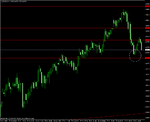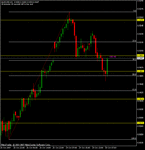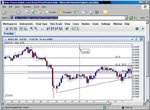trader_dante
Veteren member
- Messages
- 4,535
- Likes
- 1,704
Market call - Aud/Cad *Update 3*
And out we come for break even...
This call will hopefully have shown you how I plan a trade and how I manage it whilst I am in it.
It will also tell you a little bit about exits.
A trader could have made profit on this trade.
Remember - WE KNEW BEFORE IT GOT THERE that the market could stall at this level. And it did.
When the S/R didn't hold and the market started coming back, a trader could have closed.
I put the word "could" in bold because I still believe that it is worth giving a trade like this that has a good, solid reason for entry, some room to move.
Some traders would argue that with the risk being what it was (36 pips for me) and the first resistance being so close (22 pips from entry for me) that this wasn't the best risk/reward trade to take in the first place.
Here I would ask you to remember that the two levels on the chart: 0.8801 and 0.8833 are MINOR pivot levels. They are places to watch for but I wouldn't personally take them into the risk/reward calculation.
The key level - the main target - at 0.8894 was the level I had in mind. This was 115 pips above and gives a potential reward well over three times that of the risk taken.
At any rate - this was not hit and we are now flat with no profit.
A new trader will often berate themself when something like this happens. They will be annoyed and question themselves. They will ask why they let a winner turn into a breakeven trade. Why they didn't exit when the momentum turned.
An experienced trader knows that this trade didn't work out as planned but is confident that if they continue to play these trades in this way, they will come out ahead. This is their edge and they understand it.
And out we come for break even...
This call will hopefully have shown you how I plan a trade and how I manage it whilst I am in it.
It will also tell you a little bit about exits.
A trader could have made profit on this trade.
Remember - WE KNEW BEFORE IT GOT THERE that the market could stall at this level. And it did.
When the S/R didn't hold and the market started coming back, a trader could have closed.
I put the word "could" in bold because I still believe that it is worth giving a trade like this that has a good, solid reason for entry, some room to move.
Some traders would argue that with the risk being what it was (36 pips for me) and the first resistance being so close (22 pips from entry for me) that this wasn't the best risk/reward trade to take in the first place.
Here I would ask you to remember that the two levels on the chart: 0.8801 and 0.8833 are MINOR pivot levels. They are places to watch for but I wouldn't personally take them into the risk/reward calculation.
The key level - the main target - at 0.8894 was the level I had in mind. This was 115 pips above and gives a potential reward well over three times that of the risk taken.
At any rate - this was not hit and we are now flat with no profit.
A new trader will often berate themself when something like this happens. They will be annoyed and question themselves. They will ask why they let a winner turn into a breakeven trade. Why they didn't exit when the momentum turned.
An experienced trader knows that this trade didn't work out as planned but is confident that if they continue to play these trades in this way, they will come out ahead. This is their edge and they understand it.
Attachments
Last edited:



